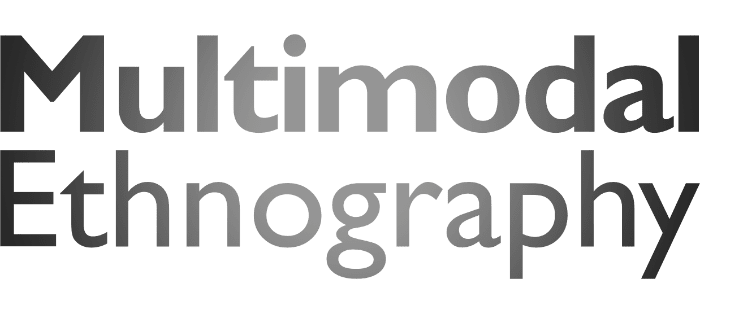Methodology & Ethics
(Word Count for total assignment: 3000-4000)
With the focus of your research better defined and your research questions clearly worked out, it is time to start thinking about how you will produce the data necessary to answer your main research question and corollary sub-questions. Whereas method refers to a particular research technique (interviewing, participant observation, questionnaire surveying, focus groups, photo elicitation, etc.), methodology is the theoretical conceptualization of the research approach. Put another way, methodology is the logic that links your research methods to your research question as well as the rationale for linking your questions to particular methods. In other words, methodology both describes how you will generate data and why the chosen methods are the best for addressing the questions identified. Visual Ethnography is thus a methodological framework that links various modalities of recording to particular epistemological, ethical, and aesthetic sensibilities. Some of your sub-questions should be specifically related to your visual ethnographic approach and output, while others sub-questions will be addressed in your written ethnographic output. That said, your thesis text should specifically draw upon your visual ethnographic methodology, while also encompassing methods that are not specifically visual. In sum, your task is to clearly and concisely explain the logic that supports your approaches in addressing the following questions. Don’t forget to make citational references to support your choices.
This is the last proposal assignment you’ll have before drafting your own complete proposal due to your supervisor by 29 November. Please don’t underestimate the time needed for this. We have intentionally left you time free at the end of November in order to focus exclusively on this task. Ideally, your four research design proposal assignments can be simply inserted into your proposal (see notes below), but in practice these will need updating, expanding, and clarifying in that process. Please refer to the sample proposals, the proposal guidelines document, and the AAA ethical guidelines for further assistance.
- Research Questions: What is your research question and sub-questions (provide the latest rendering of these)?
- Evidence / Knowledge: How will you approach each of these questions? What evidence (empirical data) do you need to be able to answer each of the sub-questions? How will that evidence afford you ways of knowing these answers? In other words, what kinds of knowledge do you hope to generate through the research process, particularly through filmic recording?
- Method / Methodology: What is the best way to gather this evidence and why is this the best way? Provide a substantive rationale for each method and how it will produce the desired evidence. You must think concretely about what you want to know and how you can best generate that information as well as what you cannot learn from each method. On the one hand, this means you need to diversify your methods so they compliment each other. On the other hand, this means considering the necessary role of experimentation and the possibility for failure. This means proceeding with ethical care, but also open to what we learn when things don’t go as expected. Unlike other sciences that rely on the reproducibility of evidence, anthropology also relies on the contingency of chance encounters. This is the generative aspect of our discipline’s process: we are making original research to generate new knowledge.
Regarding the visual anthropological research-process as a set of methods and techniques, consider the camera as an instrument of research for observation, sensory engagements, performative methods (ethnoficions, re-enactments, role play, etc.), interviews, elicitation, life-/oral history, documentation of material culture, intangible cultural heritage, geographies, landscapes, infrastructures, mappings, etc. What types of shots, compositions, framings, sequences, events, movements, scenes, juxtapositions, combinations, stories, narratives, discourses, etc. will inform your cinematic approach? How are these methods applied together with other techniques and methods in the ethnographic toolkit? - Ethics & Positionality: The ethics of an outside researcher immersing herself in the world of others in order to communicate publicly must be at the center of your methodological framework. This means thinking through the ethical implications of your chosen methods and how will you ensure the security of your participants. While you should refer to ethical standards, like the AAA code of ethics and Crowder and Marion’s list of visual ethics (cite as Marion, Jonathan and Jerome Crowder 2013 Visual Research: A Concise Introduction to Thinking Visually. Bloomsbury Academic, London. Pp. 6-7. (.pdf)), the ethics you develop and practice will be specific to the context and relationships that inform your research project. As such, you should try to situate your practice as a “research-producer” within a stated position about an anthropologist’s commitment to her/his research ‘subjects’ according to you. How do you decide which ethical standards to apply or not, and why or why not? How might various approaches affect access to and types of information collected in the field? What types of ethical concerns do you expect to encounter in the field and how do you anticipate such challenges? How might your research provoke particular sensitivities and how will you ensure your and your research collaborators’ security? How might these influence your film/research-process as well as restrictions for publication/screening? When engaging with the people in the field, how will you explain the aims of your research? How will you ensure participants’ consent? How will you use elements of reflexivity, auto-ethnography, advocacy, etc. to critically account for your positionality vis-à-vis your research?
- Analysis & Editing: In order to properly connect your methods to your questions, you need to anticipate the later phases when you return from the field and must begin to process all your research materials. How will you analyze the data you produce? What type of editing-principles and pacing will inform your cinematic approach — continuity editing, dialectical montage, the long take, etc.? How will you present the evidence and your insight to be accessible to others? Will you place emphasis on senses, emotions, speech, sound, narrative, being there, sharing ‘the gaze’ of the researcher or of the participants, etc.? What are the structuring and narrative principles? How do you anticipate your narrative structure/multimedia presentation looking like? Will the structure be inspired by anthropological analysis and/or comparison, or by a more ethnographic descriptive approach following and/or representing patterns and processes in the field? What audience(s) will be addressed by the production? How do you want the viewers to engage with the (reality of) the subject(s) of your research through the film?
- Scene Synopsis: Write a short tentative synopsis about the main persons, activities, events, storyline, moment in time, locations, etc. Indicate five or more scenes you plan to produce and briefly describe a list of possible sequences that you would record to build these scenes. Create a storyboard of these scenes using drawing as a source for imagining the field and your frame of analysis.
Peer Review
DUE: Read all your group member’s assignments prior to the Supervisory Group session on 22 November and be prepared to share your feedback.
Feedback should consider how well the methods connect to the research questions? Has the proposal linked the practical and theoretical dimensions of the research? Has the proposal accounted for challenges in producing the desired evidence? Has the proposal considered the role of ethics properly?

